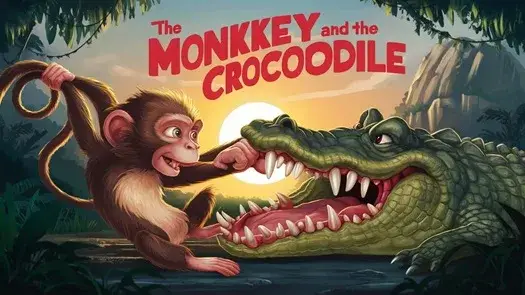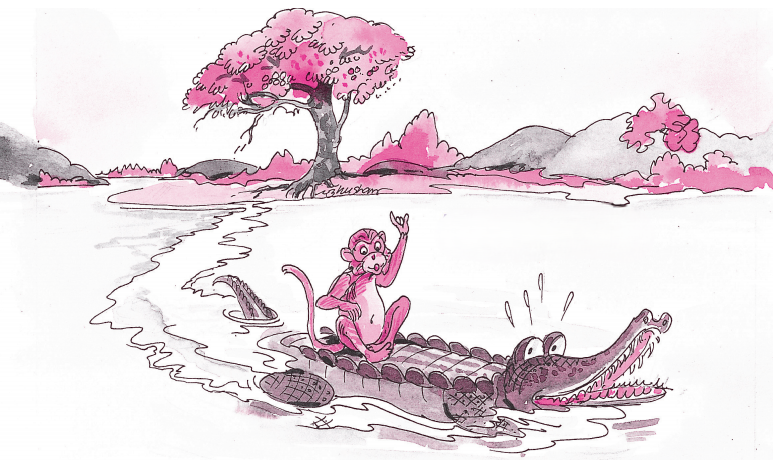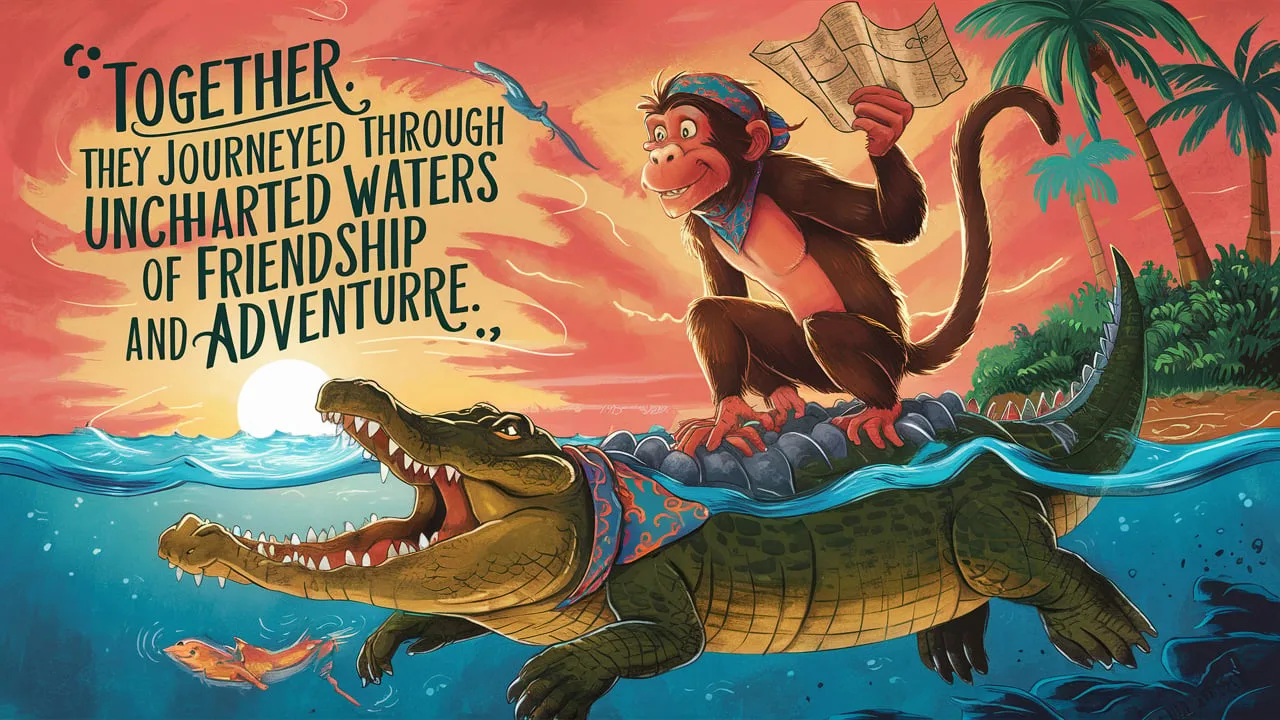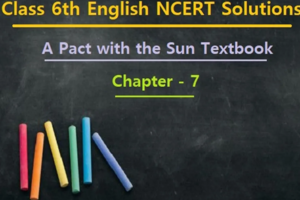
Class 6 english Chapter 5- The Monkey and the Crocodile
The Monkey and the Crocodile

The Monkey and the Crocodile” is a celebrated fable from the ancient Indian collection known as the Panchatantra, recognized for its moral teachings conveyed through captivating animal characters.The narrative centers on the friendship between a kind-hearted monkey, Miss Bandari, and a cunning crocodile, Mr. Magarmach, whose bond is tested by betrayal and deception. This tale not only entertains but serves as a poignant lesson on trust, caution, and the consequences of deceit, particularly in the context of relationships.The story’s notable themes include the contrast between trust and betrayal, underscoring the idea that genuine friendships require honesty. The crocodile’s treachery, motivated by jealousy and the manipulations of his wife, leads to a conflict that highlights the potential for moral growth and the importance of loyalty in friendships.Through the cleverness of the monkey, the fable illustrates that intelligence can often outsmart brute force, reinforcing the values of critical thinking and discernment in the face of adversity.With its enduring relevance, “The Monkey and the Crocodile” has inspired numerous adaptations across various media, from animated films to stage performances, each reinterpreting the core themes to engage contemporary audiences.
Its universal messages about friendship, loyalty, and the dangers of greed continue to resonate, making it a favored choice in educational settings for instilling essential life lessons in young learners.
Overview of the Story
The story of “The Monkey and the Crocodile” is a well-known fable from the ancient Indian collection called the Panchatantra, which is renowned for teaching moral lessons through engaging animal characters. This tale revolves around the friendship between a kind-hearted monkey and a cunning crocodile. The narrative unfolds as the monkey, named Miss Bandari, throws plums to the hungry crocodile, Mr. Magarmach, establishing a bond between them. However, the friendship is tested when the crocodile’s true intentions come into play, leading to a conflict that highlights themes of trust and betrayal.The story is not only entertaining but serves a didactic purpose by illustrating the consequences of deceit and the value of wisdom. It resonates with readers, especially children, by imparting moral lessons in a simple and relatable manner. Various adaptations of the tale exist across cultures, reflecting unique elements while maintaining the core themes of friendship and caution. Through its engaging narrative, “The Monkey and the Crocodile” continues to be a timeless story enjoyed by generations.
Main Themes
Trust and Deceit
One of the central themes in “The Monkey and the Crocodile” is the juxtaposition of trust and deceit. The story emphasizes that true friendship must be built on honesty; the crocodile’s betrayal stems from a deceptive intention to take the monkey to a feast. This deceit not only threatens the monkey’s life but also ultimately leads to the breakdown of their friendship, reinforcing the idea that dishonesty can have devastating consequences in relationships.
Loyalty and Friendship
The narrative highlights the importance of loyalty within friendships. As the story unfolds, the monkey’s cleverness allows him to escape from the crocodile’s treachery. However, it is the crocodile’s realization of his folly—listening to his wife’s deceptive counsel—that underscores the significance of remaining true to one’s friends and valuing honesty above all.
Consequences of Jealousy
The tale also addresses how jealousy can lead to harmful outcomes. The crocodile’s actions are partially driven by jealousy, as he allows himself to be swayed by his wife’s negative influence regarding the monkey. This aspect serves as a cautionary reminder of how envy can distort relationships and lead to regrettable decisions.
Critical Thinking and Problem-Solving
Furthermore, the story encourages critical thinking. Children learn from the monkey’s quick thinking in a perilous situation, illustrating that remaining calm and resourceful can help in navigating complex problems. This theme resonates with young readers, demonstrating the value of intellect and composure in the face of adversity.

Characters
The Monkey
The Monkey, while less explicitly described in the verses, serves as Kuroop’s counterpart and antagonist in the tale. He embodies wit and cleverness, often outsmarting Kuroop through his intelligence. The Monkey’s resourcefulness is highlighted in the traditional versions of the story, where he devises plans to escape Kuroop’s clutches, demonstrating the importance of quick thinking in dire situations. His character contrasts sharply with Kuroop’s more brute strength, emphasizing the moral that intelligence often triumphs over sheer power.
The Crocodile’s Wife
Though not named in the poem, the Crocodile’s wife plays a crucial role in motivating Kuroop’s actions. She represents desires and cravings, specifically a strong longing for the Monkey’s heart, which she believes to be a delicacy. Her character underscores the theme of temptation and its consequences in the story.
Kuroop the Crocodile
Kuroop is one of the primary characters in Vikram Seth’s poem “The Crocodile and the Monkey.” He is depicted as a “greeny-brown” creature with a “gentle grin,” stubby legs, and scaly skin. Kuroop is portrayed as a cunning and opportunistic hunter, stealthily gliding through the water to catch his prey, which includes dolphins, turtles, and other fish. His relationship with his wife is central to his character; he takes great pleasure in bringing home his catches for her enjoyment.
Plot
The plot of “The Monkey and the Crocodile” unfolds around a friendship between a monkey and a crocodile who live near a river. Their bond is initially strong, as the monkey resides in a berry tree that provides delicious fruit, which the crocodile enjoys. However, tension arises when the crocodile’s wife desires the monkey’s heart, believing it will grant her immortality. As the story progresses, the crocodile finds himself torn between his loyalty to his friend and his wife’s demands. He initially agrees to betray the monkey but soon faces a moral dilemma. The monkey, displaying cleverness and presence of mind, persuades the crocodile to reconsider his actions by emphasizing the importance of true friendship and loyalty. This shift in the crocodile’s decision marks a critical turning point in the plot, demonstrating that relationships built on trust can withstand temptation and conflict.Throughout the narrative, themes of discernment, loyalty, and the impact of one’s choices are highlighted. The story ultimately showcases how cleverness and moral integrity can prevail over darker desires, illustrating the broader principles of karma and rebirth, which are common in the Jataka tales.
Literary Devices
Use of Allegory
The story “The Monkey and the Crocodile” employs allegory to convey moral lessons through its characters and events. The monkey symbolizes cleverness and adaptability, while the crocodile represents deceit and treachery. The interactions between these characters highlight themes of trust and the consequences of betrayal, underscoring the importance of wisdom and caution in relationships.
Personification
Personification is a key literary device in this fable, as animals are given human traits, allowing readers to connect with the narrative on a deeper emotional level. The monkey’s cunning nature and the crocodile’s manipulative tactics are vividly illustrated through their dialogues and actions, making the moral dilemmas more relatable and engaging for the audience.
Simile and Metaphor
Similes and metaphors enhance the descriptive quality of the fable. For instance, comparisons between the monkey’s quick thinking and the crocodile’s slow, deliberate nature serve to emphasize their contrasting personalities. These literary devices not only enrich the narrative but also reinforce the central moral that intelligence can outwit brute force.
Structure and Rhythm
The narrative structure of “The Monkey and the Crocodile” follows a clear progression, moving from the establishment of the characters and their relationship to the conflict and resolution. This rhythmic flow aids in the retention of the moral lesson, as readers can easily follow the storyline and reflect on its implications.
Moral Embedded in the Conclusion
At the end of the fable, a clear moral is presented, encapsulating the story’s lessons. This technique serves to reinforce the educational aspect of the fable, making it not only a source of entertainment but also a guide for ethical behavior. The simplicity of the moral allows it to resonate with audiences of all ages, ensuring its relevance across generations.
Moral Lessons
The “Monkey and Crocodile” story imparts several crucial moral lessons relevant to children and young students, particularly in shaping their understanding of trust, intelligence, and the consequences of one’s actions.
Importance of Critical Thinking
At its core, the tale emphasizes the value of intelligence and quick thinking. The monkey’s ability to remain calm and devise a clever escape plan ultimately saves his life when faced with danger from the crocodile. This lesson is particularly significant for children as it encourages them to think critically and act wisely in various situations, especially under pressure.
Caution Against Blind Trust
Another critical lesson from the story is the caution against blind trust. While the monkey initially shares his fruits with the crocodile, he learns that trust must be earned and not given indiscriminately. The betrayal by the crocodile serves as a reminder that some individuals may have hidden motives, reinforcing the importance of discernment in relationships.
Consequences of Greed and Deception
The story also serves as a cautionary tale regarding greed and deception. The crocodile’s wife, driven by her desire for the monkey’s flesh, ultimately leads to the downfall of the crocodile’s plans. This highlights how selfishness and dishonesty often result in regret and loss, a lesson that resonates in children’s lives as they navigate social dynamics.
Friendship and Loyalty
Additionally, the narrative reflects the complexities of friendship and loyalty. While the story showcases the betrayal of the crocodile, it also underscores the potential for genuine friendship that requires honesty and integrity. This duality helps children understand that true friendships can endure challenges when built on mutual trust and respect.
Adaptations
Overview of Adaptations
The story of “The Monkey and the Crocodile” has inspired a variety of adaptations across different media, showcasing its enduring appeal and the versatility of its themes. These adaptations range from animated films to stage productions, illustrating how classic tales can be reinterpreted to engage new audiences.
Animated Adaptations
One notable adaptation is the animated short film produced by the Indian animation studio Toonz Animation. This film retains the essence of the original story while introducing unique twists and turns that enhance audience engagement. By incorporating modern animation techniques, it brings the characters and their moral dilemmas to life in a visually captivating manner.
Theatrical Interpretations
The tale has also been adapted for the stage, with various theater companies worldwide producing performances under titles such as “Crocodile and Monkey.” These adaptations often integrate music and dance, adding an extra layer of dynamism and making the story accessible to a wider range of audiences. The incorporation of live performance elements allows for an interactive experience that further emphasizes the story’s moral lessons.
Cultural Significance
The continued popularity of “The Monkey and the Crocodile” can be attributed to its themes of deceit and survival, which resonate across cultures and generations. The adaptability of the story to different forms, such as literature, film, and theater, speaks to its universal relevance and the intrinsic value of storytelling in human culture. As it evolves through various adaptations, the tale remains a powerful medium for imparting moral lessons and entertaining diverse audiences.
Reception
The story of “The Monkey and the Crocodile” has garnered significant appreciation for its moral teachings and engaging narrative, making it a popular choice in educational settings for young learners. It is particularly noted for imparting essential life lessons such as trust, intelligence, and caution in relationships, especially among children who are beginning to develop their moral frameworks.
Educational Impact
Within educational contexts, this story has proven to be an effective tool for teaching moral values. Its narrative format resonates well with students, making complex ethical concepts more digestible. The use of animal characters allows for imaginative engagement, which can enhance retention and understanding of the lessons conveyed.
Cultural Significance
The tale is part of a larger tradition of storytelling that spans various cultures, each offering its unique adaptations while maintaining universal themes. This adaptability makes “The Monkey and the Crocodile” a valuable resource for educators worldwide, promoting discussions on friendship and the consequences of deceit. The moral implications, such as the triumph of cleverness over greed, offer a positive outlook that encourages resilience and critical thinking in young minds.
FAQs (Frequently Asked Questions) on Class 6 English Chapter 5, ” The Monkey and the Crocodile”:
1. What is the story of “The Monkey and the Crocodile” about?
The story is a folktale about a clever monkey and a crocodile. The monkey lives on a tree that bears sweet fruits and befriends a crocodile. However, the crocodile’s wife plots to eat the monkey’s heart. The story shows how the monkey uses his intelligence to escape the crocodile’s trap.
2. Who are the main characters in the story?
The main characters are:
- The Monkey: A clever and resourceful animal who lives on a fruit tree.
- The Crocodile: A friendly but easily influenced crocodile who is manipulated by his wife.
- The Crocodile’s Wife: She is greedy and wants to eat the monkey’s heart.
3. How does the monkey outsmart the crocodile?
The monkey outsmarts the crocodile by telling him that he had left his heart on the tree when the crocodile tries to take him to his wife. The crocodile believes him, and when they return to the tree, the monkey quickly escapes.
4. What is the moral of the story?
The moral of the story is that intelligence and presence of mind are powerful tools to escape danger. The monkey’s quick thinking helps him avoid being eaten by the crocodile.
5. Why does the crocodile’s wife want to eat the monkey’s heart?
The crocodile’s wife believes that eating the monkey’s heart will make her stronger and healthier because the monkey has been eating the sweet, nutritious fruits from the tree.
6. Why did the crocodile agree to trick the monkey?
The crocodile, though initially friends with the monkey, was swayed by his wife’s demands. He valued his relationship with his wife more and decided to betray the monkey by luring him into a trap.
7. What lesson does the crocodile learn at the end of the story?
The crocodile learns that deceit and greed can ruin friendships. He regrets losing his friend, the monkey, due to his wife’s greed and his own lack of judgment.
8. How does the monkey feel after escaping the crocodile’s trap?
The monkey feels relieved and proud of his cleverness. He is also wiser, realizing that he should be more cautious in choosing his friends.
9. What role does the river play in the story?
The river acts as both a barrier and a means of travel. It is the place where the crocodile takes the monkey to try to fulfill his wife’s demand, but it also becomes the setting where the monkey uses his cleverness to escape.
10. How does the story highlight the theme of friendship?
The story shows how true friendship requires trust and loyalty. The crocodile betrays the monkey, which leads to the loss of their friendship. It teaches that dishonesty can destroy even the strongest bonds.
Also Visit: Readspot



4 Comments
https://virtual-local-numbers.com/countries/1240-india-toll-free-numbers.html
This magnificent phrase is necessary just by the way
https://teachingbd24.com/1xbet-registration-bd/
buy israel virtual phone number online https://virtual-local-numbers.com/countries/9-israel.html for calls, sms, registration (otp)